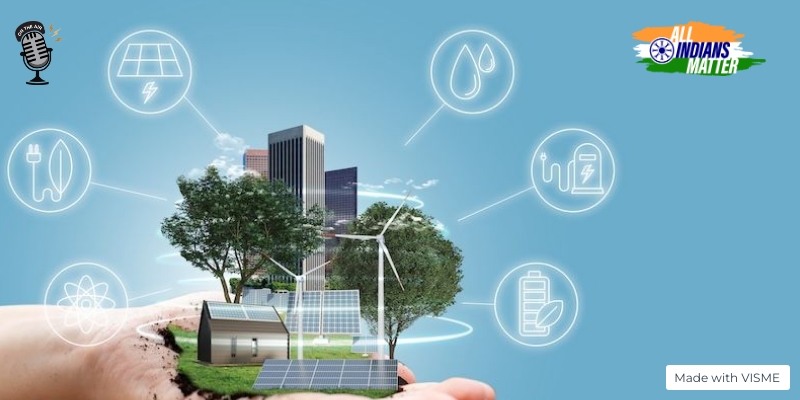Ashraf Engineer
October 28, 2023
EPISODE TRANSCRIPT
Hello and welcome to All Indians Matter. I am Ashraf Engineer.
2022-23 was a record year for India’s residential real estate market with an estimated 36% increase over the previous financial year. By the end of this decade, India is likely to become the world’s top consumer of cement, overtaking China. But, there’s a downside – construction accounts for 40% of carbon emissions in India and it uses massive amounts of valuable resources such as water and generates a lot of waste. So, on the one hand, India needs to build cities, infrastructure and homes but it also needs to ensure it is safeguarding the environment. How can India insitutionalise sustainable construction to ensure its ambitions balance its responsibility towards the climate?
SIGNATURE TUNE
Construction may account for high emissions but that’s precisely why we need to look for solutions within that industry. It has the greatest greenhouse gas mitigation potential with least capital invested. Globally, studies show that green buildings save up to 30% of energy and 50% of water, reducing maintenance costs by 25%. By adopting sustainable design and construction, buildings can be made climate-resilient and generate less trash.
Globally, and especially in India, it’s urban settings that create unsustainable trends. And so it’s urban residential construction that we need to address. The expertise to do this, from solar energy to energy-efficient materials, already exists.
So, what is sustainable construction?
In construction, carbon emissions are of two types—embodied and operational. Embodied carbon is associated with materials and building processes. It includes carbon generated during the manufacture of building materials such as steel or cement as well as its transportation. Operational carbon is what is emitted through the lifetime of the building — from, say, lighting or air-conditioning.
One way to balance this is renewable energy, such as solar. And sustainability needs to be built in at the concept stage itself. The questions builders could ask are, how can we minimise use of groundwater? What materials are available at the site itself so that we reduce their transportation from elsewhere? How do we recycle the water being used? Can we reduce installation of cooling systems by ensuring greater ventilation?
Greener materials such as fly-ash bricks can also decrease the use of carbon-intensive materials.
Net-zero buildings, or carbon-neutral buildings, produce as much renewable energy as they consume. These are energy-efficient structures that use sustainable construction materials and advanced technologies for energy management. They can play a pivotal role in combating climate change.
The government has, over the years, introduced certifications to encourage their construction and these ratings play a vital role in establishing trust among consumers.
One example of this is the Bureau of Energy Efficiency’s Net Zero Energy Building Certification introduced in 2018. The programme evaluates aspects such as energy-efficient design, energy conservation measures, renewable energy generation, etc, based on which it issues a certification.
GRIHA+ Net Zero is a national rating system that focuses on buildings that achieve net-zero energy, water and waste. It looks at energy efficiency, renewable energy generation, water conservation, waste management and indoor environmental quality.
These certifications incentivise the efforts of sustainable developers.
It’s not always easy, of course. There are several challenges to sustainable construction.
First, costs. Who can the builder pass on the cost to? This is especially problematic for small builders. Their buyers aren’t always willing to cough up more even though sustainable facilities may bring down their costs in the long run by 20% to 30%.
Second, lack of awareness. In the absence of established standards, databases and measurements of carbon emissions, not everyone understands the significance of climate action. It’s a challenge to create a meaningful connection between the users of the building and the cause. At the same time, even builders are sceptical about alternative materials such as fly-ash or adobe bricks. For them, these are new and untried, and the tendency is to stick to the tried and tested.
It is, therefore, important to deploy data and information effectively. For instance, there is research to show that green buildings improve the health and productivity of their users – which more than makes up for the 5% to 10% higher cost of construction.
Covering the roof of an uninsulated building with plants lowers the amount of energy used in cooling by as much as 33% per cent in the summer. Replacing black asphalt and roof shingles with plants can lower the surrounding air temperature too.
Incidentally, cities are often warmer than rural areas because their dark surfaces absorb the sun’s rays and radiate heat. Green buildings can help reduce this effect, which is known as ‘urban heat islands’.
Indoor air pollution is a huge environmental risk too. Studies show that there are fewer mould spores and microbes in rooms where plants cover one-third of the floor space compared to a room with no plants.
So, green spaces meet all the criteria of the ‘triple bottomline’, which refers to ‘people, planet and profit’.
In India, there is a clear need for further regulations. Our commitment to climate goals demands a more aggressive focus on net-zero buildings. By introducing regulations that encourage construction of net-zero buildings, India can accelerate its transition to a low-carbon environment. The regulations could include tax benefits and faster permissions.
The net-zero construction industry is a promising sector by itself and could hugely benefit the economy. Many corporations are setting net-zero targets and, therefore, looking at net-zero buildings as part of their overall strategy.
However, the concept of such buildings is a long way from universal acceptance or even awareness. However, their benefits are undeniable. It’s high time we start thinking of how to make green buildings the norm.
Thank you all for listening. Please visit allindiansmatter.in for more columns and audio podcasts. You can follow me on Twitter at @AshrafEngineer and @AllIndiansCount. Search for the All Indians Matter page on Facebook. On Instagram, the handle is @AllIndiansMatter. Email me at editor@allindiansmatter.in. Catch you again soon.






